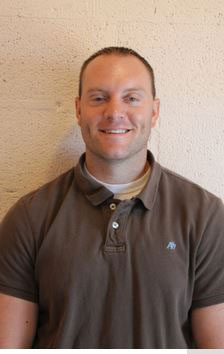Kansas Profile – Now That’s Rural: Chris Broeckelman, Natoma woodworking
October 9, 2019
By Ron Wilson, director of the Huck Boyd National Institute for Rural Development at Kansas State University.
“If you can dream it, you can do it.” That inspirational slogan might describe the work of Chris Broeckelman and his industrial technology students at Natoma High School. They are using their classes to develop skills, not just in the shop, but in life. It’s today’s Kansas Profile.
At right: Chris Broeckelman, Natoma Woodworking | Download this photo
Chris Broeckelman is the industrial technology instructor at Natoma High School in northwest Kansas. Chris grew up on a farm near Selden, one of eight children of Joe and Cathy Broeckelman.
“I always had an interest in carpentry,” Chris said. During high school, he worked at the local lumberyard. “I had a high school woodworking teacher that I thought very highly of.”
Chris studied Technology Studies and Secondary Education at Fort Hays State with a minor in business. He also worked at a cabinet shop. After graduation, he took the teaching position at Natoma. He married Megan. They now have six children.
“When I was five or six years old, I said I wanted to be a carpenter or a vegetable farmer when I grew up,” Chris said. “Now I’m teaching woodworking and have a big garden, so I’m about there.”
His industrial technology program begins with basic mechanical drafting, autocad, and woodworking classes during junior high. At the high school level, the elective classes in computer aided design and woodworking become progressively more challenging each year.
The woodworking program begins with wood processing where students learn about milling methods, identifying trees, and different drying processes. It progresses to the students imagining, designing and building a project of their own. Safety is the top emphasis throughout.
The wood is sourced locally. Farmers or power companies often donate logs which the students can cut. This year, windstorms uprooted several trees. “Ninety percent of our wood comes from salvage,” Chris said. “We resell the wood at cost to the students, which saves parents and kids thousands of dollars and supports the program.” Walnut, hackberry and white oak are popular.
The state technology competition is a motivational tool for Chris’s students. For more than 50 years, Fort Hays State University has conducted a Western Kansas Technology Fair competition open to any school in the state. Outside judges evaluate the quality of the entries. There are competitions in drafting, graphic communications, power, energy and transportation systems, plus production systems, including metalwork and woodwork, which is the largest category.
Participants receive white, red, or blue ribbons depending on the quality of the work. Superior products can be awarded a gold rosette. “It takes a lot of work to get that,” Chris said. “The kids make a big deal of it.”
More than 300 projects were entered last year. “Eleven of my 19 high school students brought home rosettes,” Chris said. Among Chris’s students, a sixth grader, eighth grader and freshman won best in class overall. Natoma has consistently been a top winner.
That’s a remarkable record for students from a school in a rural community such as Natoma, population 335 people. Now, that’s rural.
What products do students build? “The sky’s the limit,” Chris said. “I tell them, `If you can dream it up, we’ll find a way to build it.’ And they challenge me.” Projects typically include bedroom sets, dressers, dining room tables, coffee tables, and many more.
“Quality is our goal,” Chris said. “I tell them that they’re building a project that their grandkids can fight over after they’re gone.”
Not only are they building a project that will last, they are learning life skills. “To see a kid who starts with no confidence and see them grow is huge,” Chris said. “It’s about having a challenge and overcoming it, problem-solving and learning to work with others. It’s more than just wood-working, we’re teaching life.”
“If you can dream it, you can do it.” This teacher and his students are making that motto reality. We salute Chris Broeckelman and his students at Natoma High for making a difference with their creativity and skill. When a young student earns that rosette at the state competition, it can be like a dream come true.
Audio and text files of Kansas Profiles are available at http://www.kansasprofile.com. For more information about the Huck Boyd Institute, interested persons can visit http://www.huckboydinstitute.org.
----------------
The mission of the Huck Boyd National Institute for Rural Development is to enhance rural development by helping rural people help themselves. The Kansas Profile radio series and columns are produced with assistance from the K-State Research and Extension Department of Communications News Media Services unit. A photo of Ron Wilson is available at http://www.ksre.ksu.edu/news/sty/RonWilson.htm.

